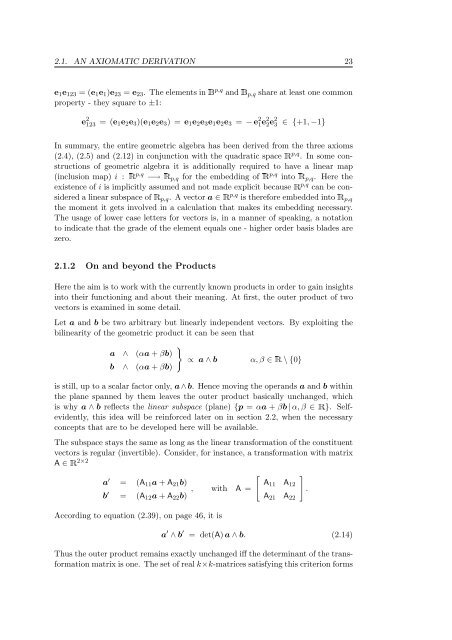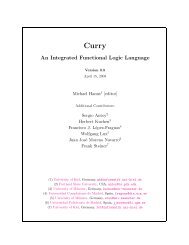Conformal Geometric Algebra in Stochastic Optimization Problems ...
Conformal Geometric Algebra in Stochastic Optimization Problems ...
Conformal Geometric Algebra in Stochastic Optimization Problems ...
You also want an ePaper? Increase the reach of your titles
YUMPU automatically turns print PDFs into web optimized ePapers that Google loves.
2.1. AN AXIOMATIC DERIVATION 23<br />
e1e123 = (e1e1)e23 = e23. The elements <strong>in</strong> � p,q and �p,q share at least one common<br />
property - they square to ±1:<br />
e 2 123 = (e1e2e3)(e1e2e3) = e1e2e3e1e2e3 = −e 2 1e 2 2e 2 3 ∈ {+1, −1}<br />
In summary, the entire geometric algebra has been derived from the three axioms<br />
(2.4), (2.5) and (2.12) <strong>in</strong> conjunction with the quadratic space � p,q . In some constructions<br />
of geometric algebra it is additionally required to have a l<strong>in</strong>ear map<br />
(<strong>in</strong>clusion map) i : � p,q −→ �p,q for the embedd<strong>in</strong>g of � p,q <strong>in</strong>to �p,q. Here the<br />
existence of i is implicitly assumed and not made explicit because � p,q can be considered<br />
a l<strong>in</strong>ear subspace of �p,q. A vector a ∈ � p,q is therefore embedded <strong>in</strong>to �p,q<br />
the moment it gets <strong>in</strong>volved <strong>in</strong> a calculation that makes its embedd<strong>in</strong>g necessary.<br />
The usage of lower case letters for vectors is, <strong>in</strong> a manner of speak<strong>in</strong>g, a notation<br />
to <strong>in</strong>dicate that the grade of the element equals one - higher order basis blades are<br />
zero.<br />
2.1.2 On and beyond the Products<br />
Here the aim is to work with the currently known products <strong>in</strong> order to ga<strong>in</strong> <strong>in</strong>sights<br />
<strong>in</strong>to their function<strong>in</strong>g and about their mean<strong>in</strong>g. At first, the outer product of two<br />
vectors is exam<strong>in</strong>ed <strong>in</strong> some detail.<br />
Let a and b be two arbitrary but l<strong>in</strong>early <strong>in</strong>dependent vectors. By exploit<strong>in</strong>g the<br />
bil<strong>in</strong>earity of the geometric product it can be seen that<br />
a ∧ (αa + βb)<br />
b ∧ (αa + βb)<br />
�<br />
∝ a ∧ b α, β ∈ � \ {0}<br />
is still, up to a scalar factor only, a ∧b. Hence mov<strong>in</strong>g the operands a and b with<strong>in</strong><br />
the plane spanned by them leaves the outer product basically unchanged, which<br />
is why a ∧ b reflects the l<strong>in</strong>ear subspace (plane) {p = αa + βb |α,β ∈ �}. Selfevidently,<br />
this idea will be re<strong>in</strong>forced later on <strong>in</strong> section 2.2, when the necessary<br />
concepts that are to be developed here will be available.<br />
The subspace stays the same as long as the l<strong>in</strong>ear transformation of the constituent<br />
vectors is regular (<strong>in</strong>vertible). Consider, for <strong>in</strong>stance, a transformation with matrix<br />
A ∈ � 2×2<br />
a ′ = (A11a + A21b)<br />
b ′ = (A12a + A22b)<br />
, with A =<br />
Accord<strong>in</strong>g to equation (2.39), on page 46, it is<br />
� A11 A12<br />
A21 A22<br />
a ′ ∧ b ′ = det(A)a ∧ b. (2.14)<br />
Thus the outer product rema<strong>in</strong>s exactly unchanged iff the determ<strong>in</strong>ant of the transformation<br />
matrix is one. The set of real k×k-matrices satisfy<strong>in</strong>g this criterion forms<br />
�<br />
.
















